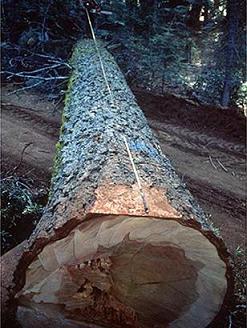In 1979 Indonesia
became the largest tropical log producer in the world, commanding
41% of the global market segment (2.1 billion dollars). This volume
was larger than the collective exports of Africa and Latin America
(Gillis, 1988:43-104). All of this timber, both unprocessed and in
the form of plywood, was exported to a number of destination
countries, such as Hong Kong, Japan, China, Australia, West Germany
(at the time), France, Singapore, Benelux and England.
Also
at this time, the forests took second place after oil as the largest
contributor to the national economy.
In 1994, ten of the
largest forest concession company conglomerates controlled 28.18
million ha (45 percent) of the forest concessions in the country .
These companies then formed a cartel (Apkindo) that made Indonesia
the largest plywood producer in the world and successfully increased
the international price of plywood . The total income produced
reached US$ 5.5 billion, equivalent to 15% of entire export earnings
.
In 1995, about 585 forest concessions carried out logging
on 62.5 million ha throughout Indonesia. They seized more than 62.5
million (49%) of natural forests in Indonesia which were thereafter
termed “State forests”. About 28.18 million ha of them were
controlled by just 10 companies.
In 1996, there
were 445 forest concession holders covering an area of 54,060,599
hectares. Almost 50% of these were controlled by the same 10
companies. Nevertheless, in the mid 1990s, several of forest
concessions were retracted. In a proportion of these cases, the
forest concession holders had violated the law, while in other cases
the tree stand value in the forest concession had deteriorated.
Brown estimates that the total number of forest concessions had
declined to 464 while the forest area under forest concessions had
declined to 52 millions ha. In practice, the “retraction” of more
than 100 forest concession licenses did not stop activities. Some
forest concessions, whose 20 year contract period had ended, were
shifted to five State-owned forestry enterprises (Inhutani I to V).,
or were re-formed as a partnership between the private company and
one of the State-owned companies.
It was in this period of
joint logging that Soeharto made the forests both a tool and a gift
for national rule.
This gift was given in the form of forest
concessions, industrial plantations and plantations for Soeharto’s
family, friends, and work colleagues, as well as to key members of
the military and political elite, in order to guarantee their
loyalty. Automatically, those who controlled the forests also had
enormous wealth and influence.
The Government then issued
regulations in regards to forest concessions that made it necessary
for companies to apply for forest concessions in order to own or
form relationships with other companies that owned timber processing
factories. In this way, a small number of giant companies
consolidated their domination, by controlling both upstream (forest
concessions) and downstream (plywood industry)
simultaneously.
The number of plywood factories in Indonesia
increased from 21 in 1979 to 101 in 1985, while production increased
from 624,000 m3 in 1979 to almost 4.9 million m3 in 1985, before
doubling again to more than 10 million m3 in 1993. Almost 90% of
plywood production that year was exported .
In mid-1998, only
39 million ha remained in the hands of private forest concession
holders, while 14 million ha were managed by five State-owned
enterprises. Some 8 million ha were under the control of
State-private partnerships, and another 8 million ha were converted
to non-forestry use . The Armed Forces (ABRI) also profited from
this redistribution of forest concessions; their forest concessions
increased almost two-fold, to a total 1.8 million ha (Brown,
1999:12, 40).
In 2004, the number of forest concession
holders was only 279 companies. About 107 of these were declared
inactive.
In 2006, with production in 57,620,301.69 ha of
remaining forests, 303 companies were recorded as having logging
permits (IUPHHK, which replaced HPH) that controlled 28,104,978 ha
of forests.
Of the 303 Logging Permits in 2006, only 149 units were
still active with an area of 14,604,069 ha. The remaining 154
units (with an area of more than 17,381,534 ha) were declared
inactive. The Government’s reasons included: permit-holding
companies were unhealthy, unprofessional, had poor commitment,
internal conflicts and other permit-holders only wanted to control
the land as “rent seekers”.
|
Meanwhile, influential external factors
included the inconsistency between the central and local
Governments, illegal logging problem, security aspects, business
uncertainty, lack of incentives and excessive demands from the local
community. Although companies verified these reasons, they also
complained about the high costs of production due to the many tolls
and levies, outside of official regulations, that had to be paid
were not comparable to the costs of production. The
Government will auction off these inactive forest concessions for
transformation into industrial plantation zones. In 2007, the
Government plans to increase the logging quota from 8.4 million m3
per year to 9.1 million m3 per year.
Next >>>
(http://www.eng.walhi.or.id/) |
 |
 |
|

